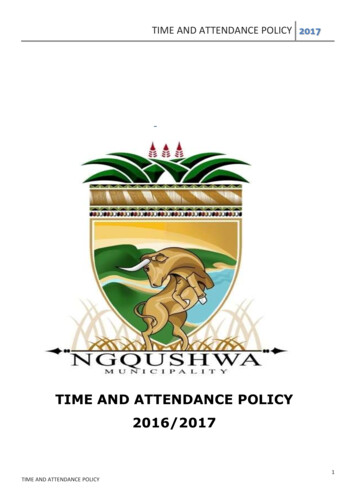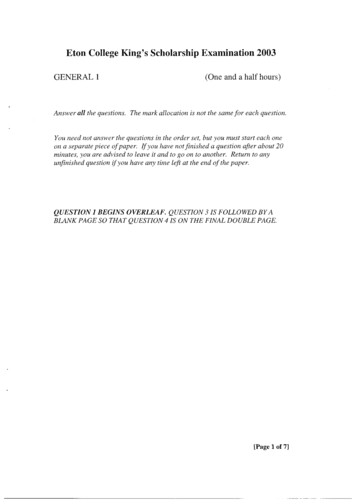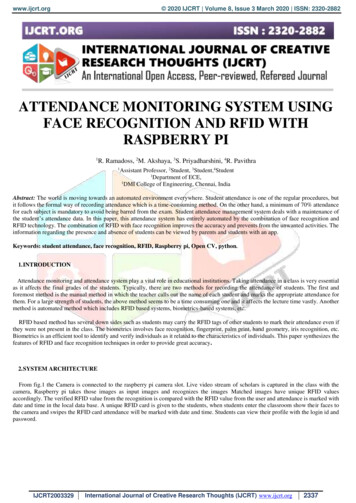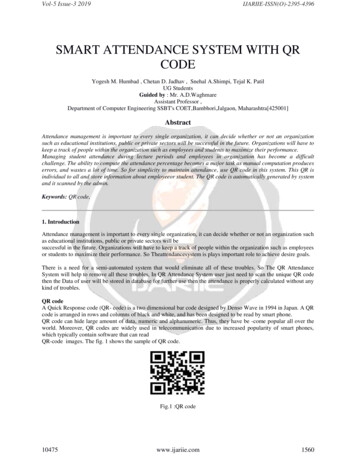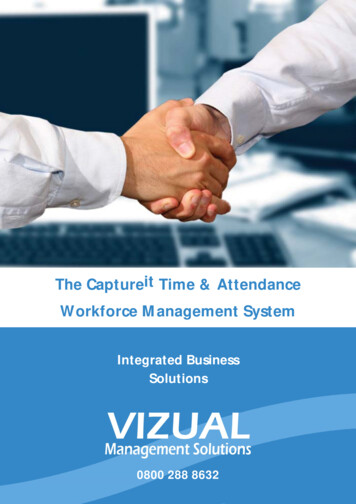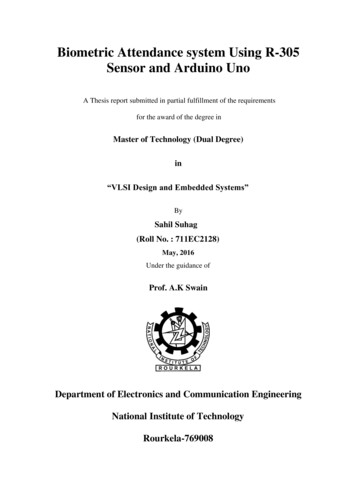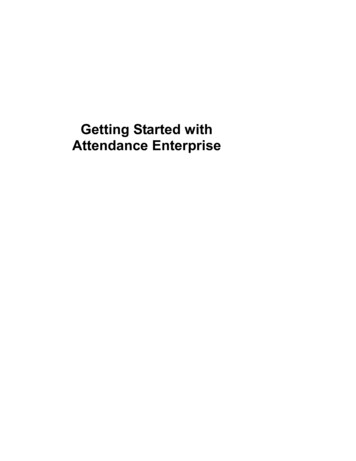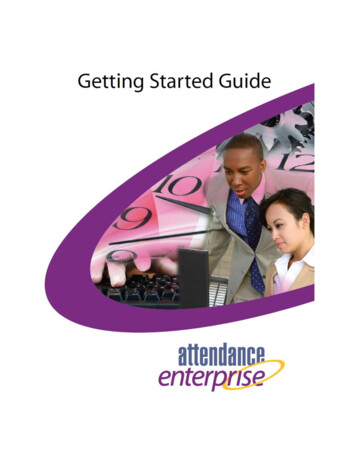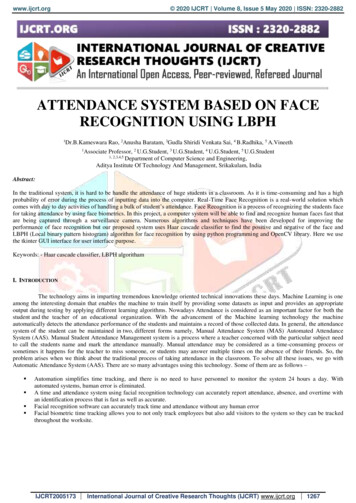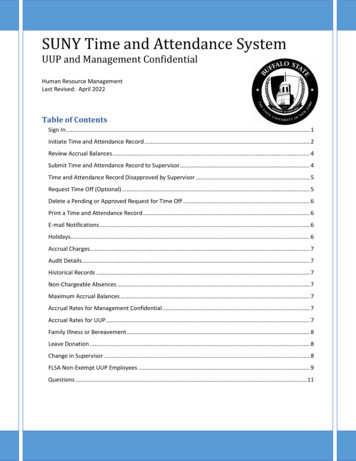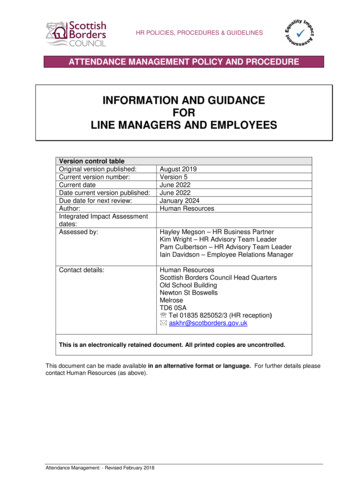
Transcription
HR POLICIES, PROCEDURES & GUIDELINESATTENDANCE MANAGEMENT POLICY AND PROCEDUREINFORMATION AND GUIDANCEFORLINE MANAGERS AND EMPLOYEESVersion control tableOriginal version published:Current version number:Current dateDate current version published:Due date for next review:Author:Integrated Impact Assessmentdates:Assessed by:Contact details:August 2019Version 5June 2022June 2022January 2024Human ResourcesHayley Megson – HR Business PartnerKim Wright – HR Advisory Team LeaderPam Culbertson – HR Advisory Team LeaderIain Davidson – Employee Relations ManagerHuman ResourcesScottish Borders Council Head QuartersOld School BuildingNewton St BoswellsMelroseTD6 0SA Tel 01835 825052/3 (HR reception) askhr@scotborders.gov.ukThis is an electronically retained document. All printed copies are uncontrolled.This document can be made available in an alternative format or language. For further details pleasecontact Human Resources (as above).Attendance Management: - Revised February 2018
HR POLICIES, PROCEDURES & GUIDELINESATTENDANCE MANAGEMENT POLICY AND PROCEDUREContents Page:Page No.1.2.3.4.5.6.7.ScopeIntroductionAims and ObjectivesPrinciplesRoles and ResponsibilitiesMedical appointmentsEquality Act 2010 and Attendance Management Disabilities Gender Reassignment Religious Observations and Pilgrimages8. Sickness Absence Reporting Procedure9. Return to work meetings10. Sickness During Annual Leave11. Unauthorised Absence12. Pattern Absence12. Pattern Absence13. Occupational Sick Pay14. Attendance Management Procedure15. Conducting a return to work meeting16. Short Term Absences - Informal Guidance/ReviewMeetings (Stage 1)17. Short Term Absences – Formal Stages (Stages 2, 3 and4)18. Attendance Management Hearings19. Those Authorised to Chair an Attendance ManagementHearing20. Possible Hearing Outcomes21. Conducting a formal Attendance Management Hearing(Stage 2 - Written Warning)22. Conducting a formal Attendance Management Hearing(Stage 3 – Final Written Warning)23. Conducting a formal Attendance Management Hearing(Stage 4 – Dismissal)24. Failure to Maintain Improved Attendance25. Right of Appeal26. Long Term Absences27. Referral to Occupational Health28. Possible Adjustments29. Unable to Return to Work30. Formal Attendance Management Hearing31. Combined Short and Long Term Absence32. Revision of the Attendance Management 2222324242526262727
HR POLICIES, PROCEDURES & GUIDELINESList of Appendices:Page 20.21.22.23.24.25.26.27.28.29.3Managing Employees with a disability guidanceNotifying an Absence – FlowchartCertifying an Absence/Returning to Work – FlowchartAttendance Management Procedure – Short TermAttendance Management Procedure – Long TermEmployee Attendance Record and Contact SheetReturn to Work – GuidanceGuidance on Holding Informal Guidance/ReviewMeetings – Stage 1Letter Informal guidance meetingAttendance Management ReportGuidance on Conducting a formal AttendanceManagement Hearing – Stages 2, 3 and 4Letter formal Attendance Management Hearing (stages2 & 3)Letter formal Attendance Management Hearingmeeting (stage 4)Letter Confirming Outcome of Attendance ManagementHearing – Stages 2 and 3Letter Confirming Outcome of Attendance ManagementHearing – Stage 4 (Dismissal)Letter Confirming Outcome of Attendance ManagementHearing – Stage 4 (Capability Dismissal)Letter Confirming Outcome of Attendance ManagementHearing – Stage 4 (Ill Health Referral)Letter Confirming Completion of Review PeriodConducting an Appeal Hearing by ManagementLetter Confirming Arrangements for Appeal HearingLetter Confirming Outcome of Appeal HearingConducting an Appeal by CommitteeFormat for Preparing Papers for the Council StaffingAppeals Committee.Stress Management Report Form (AM3)Certificate of Permanent Ill HealthOccupational Health Referral TemplateStatutory Sick Pay GuidanceIll health retirement and pensionsUseful 5961687074767779
HR POLICIES, PROCEDURES & GUIDELINES1.Scope1.1This procedure applies to all employees of Scottish Borders Council (“the Council”)regardless of status and length of service with the exception of: The Chief Executive1.2The policy and procedure has been agreed in consultation with the Council’s recognisedTrades Unions: GMB, Unison, Unite, Educational Institute of Scotland (EIS), and ScottishSecondary Teachers Association (SSTA).1.3This policy is associated to the following key policies/guidelines and where applicableshould be cross referenced to gain further detail: Accident and Incident Reporting PolicyCorporate Health & Safety PolicyDisciplinary ProcedureDomestic Violence PolicyEquality Diversity & Human Rights PolicyMentally Healthy Workplace and Stress Management PolicySpecial Leave GuidelinesSubstance Misuse Policy.2.Introduction2.1The Council’s Attendance Management policy recognises the need for a procedure whichwill benefit the council, protect employees and improve services to customers.The introduction of the Attendance Management Policy and Procedure and supportingguidance is a positive step by the Council to provide effective support to employees whoare absent from work due to sickness or medical treatment.Absence can be a difficult subject and when poorly handled or ignored it can quicklymultiply as employees realise absence is rarely questioned or challenged. At the sametime it can create an environment of resentment, disinterest and discontent amongstother employees.In most cases sickness absences are unavoidable and completely genuine; howeverthere are sometimes a small number of people who abuse the system.The following aims to address both of these groups in differing ways by: 2.2.Supporting employeesTaking effective action where necessary.Supporting employeesOne of the most successful ways of impacting on sickness absences is for the employerand in particular the immediate line manager, to actively support employees, particularlythrough a prolonged period of absence, by keeping in contact with them and trying, wherepossible, to offer advice and discuss alternatives which will hopefully result in an earlyreturn to duty.4
HR POLICIES, PROCEDURES & GUIDELINESSimilarly it is equally important for the line manager to speak to employees on their returnto work following an absence (see paragraph 15, Conducting a Return to Work Meeting).This allows the employee and the manager to identify, for instance, any difficulties whichmay be contributing to sickness absence and take necessary action to resolve them.A list of contacts employees may find useful is contained in Appendix 29.2.3Taking Effective ActionThe Attendance Management Procedure provides a framework for managing absence,and will be particularly helpful in cases where the level of absence is causing concern.Effective use of the Attendance Management Procedure will ensure that managers aresupporting employees to enable them to achieve a better and acceptable level ofattendance.It is important to remember that the purpose of the Attendance Management Procedureis not to take formal action or dismiss employees but to advise and counsel them toachieve an acceptable level of attendance. However, employees should be aware thatpersistent sickness absence is regarded as a serious matter which, in some cases, couldresult in dismissal.3.Aims and objectives3.1The aims and objectives of the Attendance Management Procedure are to: Create a culture where employees feel valued, engaged, committed and involvedPromote good working practices that support work-life balance,Ensure sickness absence is managed in a fair, supportive and consistent wayMake clear the responsibilities placed on employees and managers and its relevantagencies in managing absence andAchieve and maintain levels of attendance which are consistently above the average inthe Public Sector by reducing: Overall sickness absenceAccidents, andStress related absence.4.Principles4.1.Talking at an early stage can, in many cases, resolve a problem before it becomes longterm or chronic. This is why the Return to Work discussion is a key part of the Council’sAttendance Management Procedure.4.2If the level of attendance is causing concern it will generally fall into one of the followingtwo categories: 4.35Persistent/frequent short term absence orLong term absence.Advice can be sought from the Occupational Health Service, provided by People AssetManagement (P.A.M.).
HR POLICIES, PROCEDURES & GUIDELINES4.4 Attendance Management Procedure requires that Return to Work meetings are held, andhas four subsequent levels, namely:Stage 1 – Informal GuidanceStage 2 – Written Warning/Final Written WarningStage 3 – Final Written WarningStage 4 – Dismissal4.5No formal action will be taken against an employee regarding their attendance without aformal Attendance Management Hearing. Employees will always be given the right ofappeal against any decision taken.4.6Informal Guidance/Review meetings will be held to review and monitor an employee’sattendance. These can be as frequent as required, and will certainly be held betweenformal Attendance Management Hearings.4.7Recording and monitoring attendance is a key aspect in managing attendance. Managershave access to all their employees’ absence records through BusinessWorld (the Council’sHR/ Finance system). Managers will also receive an alert through BusinessWorld andaction requires to be taken in accordance with the stages of attendance managementwithin this policy if employees hit the following “trigger points”: Any absence of 20 days or more (long term) Four or more periods of absence in any 12 month period (frequent short term) A period made up of 9 days or more in a 12 month period (short term)Reason for absence is stress/anxiety.If an employee is absent due to stress/anxiety , managers should refer to section 8 (MentalHealth and Wellbeing)for guidance. Managers should only progress through the stages setout within this policy with regards to a stress/anxiety trigger if one or more of the other triggershas also been met, ie there has been an absence for stress/anxiety and the employee hasbeen absent for a cumulative 9 days in a rolling 12 month period.4.8All employees’ absences will be recorded for the purposes of managing attendance.4.9Line managers should be aware of the Council’s following policies, procedures andguidelines: Accident and Incident Reporting PolicyCorporate Health & Safety PolicyDisciplinary ProcedureDomestic Violence PolicyEquality Diversity & Human Rights PolicyMentally Healthy Workplace and Stress Management PolicySpecial Leave GuidelinesSubstance Misuse Policy.4.10Equal treatment is important when dealing with poor attendance - this means thereshould be a consistent approach in every case. If line managers believe there is an issuerelated to a disability or gender reassignment there may be implications under theEquality Act 2010, and they should contact HR for further advice.4.11Pregnancy related absences should be disregarded for the purposes of AttendanceManagement. HR can provide specific advice if there are issues.6
HR POLICIES, PROCEDURES & GUIDELINES4.12Employees who have an illness which is terminal or life threatening, or who are sufferingfrom mental health issues such as stress or depression, will be particularly vulnerable atthis time and may find it difficult to talk openly about their employment and the effect oftheir condition on their attendance. Line managers should contact HR for further adviceif they know or believe this may apply.4.13When a manager becomes aware that an employee is suffering from mental healthissues, support should be made available through the Council’s Occupational Healthprovider.4.14While the Attendance Management Procedure is intended to provide support andassistance to employees, it is emphasised that the Council will deal firmly with caseswhere employees have taken sick leave but are not genuinely sick. In these instancesline managers should use the Council’s Disciplinary Procedure outlined in the HR Policyand Guidelines.4.15Staff in HR will offer advice and assistance at any stage in dealing with sickness absence.Contact HR on Ext 5052/5053 or askhr@scotborders.gov.uk4.16Employees may be referred to Occupational Health (P.A.M.) for advice on both shortterm and long term absences.14.17 When an Occupational Health report is received for an employee, managers willimmediately send a copy to the employee.5.Roles and Responsibilities5.1Chief Executive and DirectorsThe Chief Executive and each Director is responsible for the management of attendancewithin their department, and for determining the level of formal action which is delegatedto managers/supervisors within the department. There may, however, be occasionswhere it is appropriate for an Attendance Management Hearing to be conducted byOfficers from another Department. The authority to dismiss will be delegated no furtherthan to a Manager reporting directly to a Director level post.5.2Line ManagersAs a line manager you should at all times be aware of any patterns that are developing,so that you can take the necessary action. You are able to access the level of absencefor each of your employees on BusinessWorld. You should check these regularly andtake appropriate action. Do not rely on anyone else to prompt you! It is essential thatyou deal with persistent absence promptly, firmly and consistently. Employees who areabsent, particularly those on long term sick leave, may feel isolated and insecure. It istherefore important that line managers keep in regular contact and provide support andadvice, consulting with HR as required. .5.2.1 A line manager will: Record all periods of absence and carry out a return to work review with the employeeafter each period of sickness absence Monitor attendance Use attendance patterns and trigger alerts. Inform employees of their first point of contact on attendance issues7
HR POLICIES, PROCEDURES & GUIDELINES Follow up with employees where concerns are evident and take informal/formal actionas appropriateAct promptly, fairly and consistentlyMake full use of all the expertise, information and support available, and never evadethe issueKeep in regular contact, providing support and advice where necessaryOn becoming aware that an employee is suffering from mental health issues, makeavailable support from the Council’s Occupational Health provider (Appendix 27)Seek advice from HR when an absence is or may be related to the EqualityAct 2010 (See paragraph 7)Make arrangements for anyone who is unwell to leave work safely and/or receivemedical treatment and contact the Health & Safety Team Leader where necessary.5.3Employees5.3.1A basic requirement of all staff employed by the Council is to maintain an acceptablelevel of attendance. Employees should be aware that persistent sickness absence isregarded as a serious matter which, in some cases, could result in dismissal. Under theHealth & Safety at Work Act, every employee has a legal duty to take reasonable carefor their own Health & Safety. This includes co-operating with the employer, asnecessary, to help in the employer’s compliance with their legal duties.5.3.2 Employees will: Take measures to keep absence from work to a minimum Talk to line managers about any personal need to take time off, and arrange, whereverpossible, so that family responsibilities do not restrict availability for work at the expectedtimes Seek primary health care eg dentist, GP as appropriate Follow the agreed procedures if unfit for work Co-operate with requests to attend Occupational Health assessments Maintain contact during periods of absence, including long term absence Return to work promptly, as soon as appropriate Communicate with line managers on return to work Be familiar with and comply with the conditions which apply to the continued payment ofsick pay Complete attendance records on BusinessWorld Seek clarification from line managers (or HR) if unclear about any aspect of theAttendance Management Procedure Inform line managers if absence is or may be related to the Equality Act 2010 If taken ill or injured while at work, report to the line manger or service area’s first aidofficer.5.4Human Resources5.4.1 The role of HR is to offer line managers advice on procedures and provide assistance inindividual cases. HR can provide the following support and advice on how to: 8Conduct meetings with employees about sickness absenceManage absences which may not be genuine (through disciplinary procedures)Manage short and long term absencesRefer an employee to Occupational Health and the appropriate stage for referralAdvise on salary implications in individual casesEnsure the policy and procedure is applied correctly
HR POLICIES, PROCEDURES & GUIDELINES 5.5Monitor employee attendanceAdvise on absences that are or may relate to the Equality Act 2010. (See paragraph 7)Assist employees and managers in interpreting Occupational Health Reports (whererequired).Occupational Health5.5.1 People Asset Management (P.A.M.) is Scottish Borders Council’s current OccupationalHealth provider. They offer a variety of services to assist managers and employees on awide range of issues. It is not necessary that an employee is off sick to be referred toOccupational Health. Referrals may be made as a preventative measure. All referrals toP.A.M. are made online via the Intranet (appendix 27 provides details), normally by theemployee’s line manager.5.5.2 As detailed above, if an employee is suffering from mental health issues, such as stressor depression, the manager must ensure that support is available from P.A.M and thatthe employee is aware of this.5.5.3 Medical advice will be sought at the earliest opportunity in order to:Avoid absence, or where absence occursAssess the likely duration of the absenceAssess whether there are other factors which are affecting the absenceAdvise managers about any limitations or work related restrictions and their likelydurationAdvise managers about rehabilitation and the need for a phased return to workAdvise on specific support, or reasonable adjustments that may be required by anindividual and any equipment which may be useful andAssess the likely eligibility of an individual for ill health retirement.5.5.4 During or after a lengthy period of absence, or series of absences, an employee may berequired by the Council to attend the Occupational Health Service or other medicaladviser for independent advice. This appointment will be to assess the employee’scurrent health condition and fitness/suitability for returning to their current job. It isexpected that this referral will be considered after 4 - 6 weeks of absence, or after anumber of frequent short term absences. However, this may change in the specificcircumstances of the case. Line managers may also request that the OccupationalHealth Service obtain an opinion from the employee’s GP or, if appropriate, Consultant.5.5.5 Separately there is also a confidential Employee Assistance Programme run by P.A.M.This service is available 24 hours a day every day of the year. Employees can obtainadvice and support on any work or personal issue.5.5.6 The support provided includes telephone counselling and where appropriate face to facecounselling.5.5.7 P.A.M. can be contacted by employees via (freephone 0800 882 4102) or by visiting theP.A.M. Assist Website .www.pamassist.co.uk. The log in details are:Username: BordersPassword: Council5.5.8 Occupational Health consultations with employees are confidential and reports andadvice are provided in general terms only, i.e. they do not normally specify medicalconditions but report on the impact of a condition on the employee’s role. Help is9
HR POLICIES, PROCEDURES & GUIDELINESavailable in interpreting the report, where required, from both P.A.M. and HR. WhereOccupational Health wishes to obtain information from the individual’s GP or Consultant,they will seek the employee’s consent by obtaining a signed employee consent form (inaccordance with The Access to Medical Reports Act 1988).6.Medical appointments6.1For Hospital or other Medical appointments please see the Guidelines on SpecialLeave.7.Equality Act 2010 and Attendance Management7.1.1 The Council is committed to the principles of equality of opportunity that underpin theEquality Act 2010, both in the provision of services and in its role as an employer. Inpursuing these commitments the Council acknowledges its statutory duties under theAct, which specifically protects people who may experience discrimination, whether director indirect; harassment or victimisation in the workplace.7.1.2 No employee, job applicant, customer or recipient of services will receive lessfavourable treatment than any other on any grounds including the following: Race,colour, nationality or ethnic origin, religion or belief, sex, transgender status (includinggender identity), sexual orientation, marital status, age, disability or disadvantaged byconditions nor have requirements imposed which cannot be shown to be justifiable.7.1.3 Whilst this section refers to the Equality Act and Managing Absence it will not feature allof the protected characteristics. This is because with the exception as detailed belowthere should be no extraordinary considerations to be made whilst working through theprocedure.7.2.Disability7.2.1 The Council’s aim is to promote equality of opportunity for all employees and makereasonable adjustments to policies which disadvantage disabled employees.7.2.2 Appendix 1 contains guidance on “Managing employees with a disability”. This guidanceshould be referred to when absence is related to or may be related to an employee’sdisability. Managers must also take advice from HR in this situation.7.2.3 The Council is aware that sickness absence may result from a disability. At each stageof the Attendance Management Procedure (see paragraph 13), particular considerationwill be given to whether there are possible reasonable adjustments that could be madeto the requirements of a job or working arrangements that will provide support at workand/or assist a return to work.7.2.4. If an employee considers that they are affected by a disability or medical condition whichaffects their ability to undertake their work, they must inform their line manager or inexceptional cases, the Council’s HR Department. Managers must then contact HR forguidance. In order to support employees they are encouraged to disclose their medicalconditions, including any disabilities, although there is no legal obligation to do so.7.2.5. The Council will fund the reasonable cost of any adjustments that will provide support toan employee at work and/ or assist a return to work. Funding may also be available fromexternal organisations, such as Access to Work. https://www.gov.uk/access-towork/apply.10
HR POLICIES, PROCEDURES & GUIDELINES7.2.6 Whilst the Council will endeavour to make reasonable adjustments, employees shouldbe aware that unreasonable amounts of sickness absence is regarded as a seriousmatter which, in some cases, could result in dismissal and/ or retirement through illhealth.7.2.7 This situation will usually arise only after other options to enable the employee to continueworking have been considered and exhausted.7.3Gender Reassignment7.3.1. Gender reassignment is protected by the Equality Act and employees undertaking genderreassignment may require to be absent from work. .7.4Religious Observations and Pilgrimages7.4.1. Whilst the Council is supportive of employees who wish to practice religious observationsor undertake pilgrimages, time off to do so does not fall under the jurisdiction of thisPolicy. Applications to take time off work for the purpose of religious observance aresubject to reasonable notice being given of leave dates requested. Employees willnormally be able to use their annual leave entitlement for this purpose.7.4.2 Unauthorised absence that has resulted due to attending religiousobservations/Pilgrimages will be treated seriously and dealt with under SBC’sDisciplinary Procedure. This may result in disciplinary action being taken up to andincluding dismissal.8.Sickness absence reporting procedure8.11 - 7 days (inc. weekends) – self certificationWhere an employee is prevented by sickness from reporting for duty, the employee orsome other person acting on their behalf, must telephone the line manager, by theirnormal starting time on the first day of absence. The following details should be providedand recorded: Employee details (Name, section/location, contact details)The absence details (first day of illness or injury, whether or not a workplaceaccident/incident)Reason for AbsenceExpected date of returnAny outstanding or urgent work that requires attentionIf the employee does not make contact with their line manager directly, they must do so bythe next day or as soon as they are able. The employee should also contact their LineManager directly on the 4th and 7th day of their absence. In exceptional circumstances thefrequency and method of contact can be varied depending on the reason for the sicknessabsence, however this must be agreed between the Line Manager and employee whenthe absence is first notified and depending on the reason for the sickness absence.8.1.2. If the employee is taken ill or injured while at work, the matter must be reported to the linemanager and the employee taken to the service area’s first aid officer to assess thesituation. Line managers must make arrangements for anyone who is unwell to leave11
HR POLICIES, PROCEDURES & GUIDELINESwork safely and/or receive medical treatment and contact the Health and Safety Sectionwhere necessary.8.1.38.2.Ensure that if an accident, incident or near miss occurs, a report is made within 3 daysusing ‘Lexi’, the Council’s Health and Safety system. More information can be found onthe intranet under ‘Your Job’ – Health and Safety’.7 days and over8.2.1 Where the employee’s absence extends beyond seven days, the employee must obtainand submit a “Statement of Fitness for Work” stating that the employee is not fit for workand the reason(s) why. The statement must be forwarded to the line manager (as soonas possible and within no later than three working days) to cover the period of absencefrom the 8th day onwards. If the absence continues, further medical certificates must beprovided to cover the whole period of absence with no gaps in dates.8.2.2. Where the employee’s absence extends beyond seven days, the manager should agreewith the employee a contact period to allow the opportunity to discuss the currentposition. The nature and duration of the absence will determine how often the contactshould take place, however, it is important to take a common sense approach whendetermining the contact period.8.2.3 This contact should cover issues such as a date for a prospective return to work, or, ifany more information about the absence has become available after, for instance,following a visit to the employee’s doctor.8.2.4 If an employee has been issued with a “Statement of Fitness for Work” from their GeneralPractitioner (GP), the employee for that stated period will be unavailable for work for allpositions held within the Council (unless the GP specifies they are fit for a particular post).Failure to observe these rules will result in the withholding of payment by the Council ofStatutory Sick Pay and/or Occupational Sick Pay and may result in disciplinary action.Notes for Line Managers only8aWhen first notified of an employee’s absence the line manager must ensure that theabsence is immediately recorded in BusinessWorld. More information can be found onthe intranet under ‘Your Job’ – Business World – HR.8bEnsure that if an accident, incident or near miss occurs, a report is madewithin 3 daysusing Lexi.8cThe employee, if they believe they are displaying symptoms of stress, and they believethe symptoms are work related must complete a Stress Management Report Form(AM3) (Appendix 25) and forward to HR. HR will determine whether to pass theinformation to the Line Manager or to contact the employee direct to discuss any potentialcourse of action. Should the symptoms be non-work-related then the AM3 form may stillbe used to enable the situation to be reviewed. A list of support agencies is attached tothe AM3, and the employee is always encouraged to contact their GP. This form canalso be used when the employee has not been absent from work.12
HR POLICIES, PROCEDURES & GUIDELINES8dThe Council reserves the right to request employees to provide a “Statement of Fitnessfor Work” for any absence of seven days or less. In this case any cost incurred inobtaining the certificate will be met by the Council.8eThe manager will forward the completed “Statement of Fitness for Work” certificate to HRShared Services.Mental Health and WellbeingIf an employee believes they are displaying symptoms of stress, and they believe thesymptoms are work related, they must complete a Stress Management Report Form(AM3) (Appendix 25) and forward to HR. HR will determine whether to pass the informationto the Line Manager or to contact the employee direct to discuss any potential course ofaction.Should the symptoms be non-work-related then the AM3 form may still be used to enablethe situation to be reviewed. A list of support agencies is attached to the AM3, and theemployee is always encouraged to contact their GP. This form can also be used when theemployee has not been absent from work.Further information on support available for mental health and wellbeing is contained inthe Metally Healthy Workplace and Stress Management Policy and Guidance.9.Return to work meetings9.1On return to work, following each period of absence, the Line Manager must have adiscussion with the employee (either in person or if
12. Letter formal Attendance Management Hearing (stages 2 & 3) 47 13. Letter formal Attendance Management Hearing meeting (stage 4) 48 14. Letter Confirming Outcome of Attendance Management Hearing - Stages 2 and 3 49 15. Letter Confirming Outcome of Attendance Management Hearing - Stage 4 (Dismissal) 50 16.
